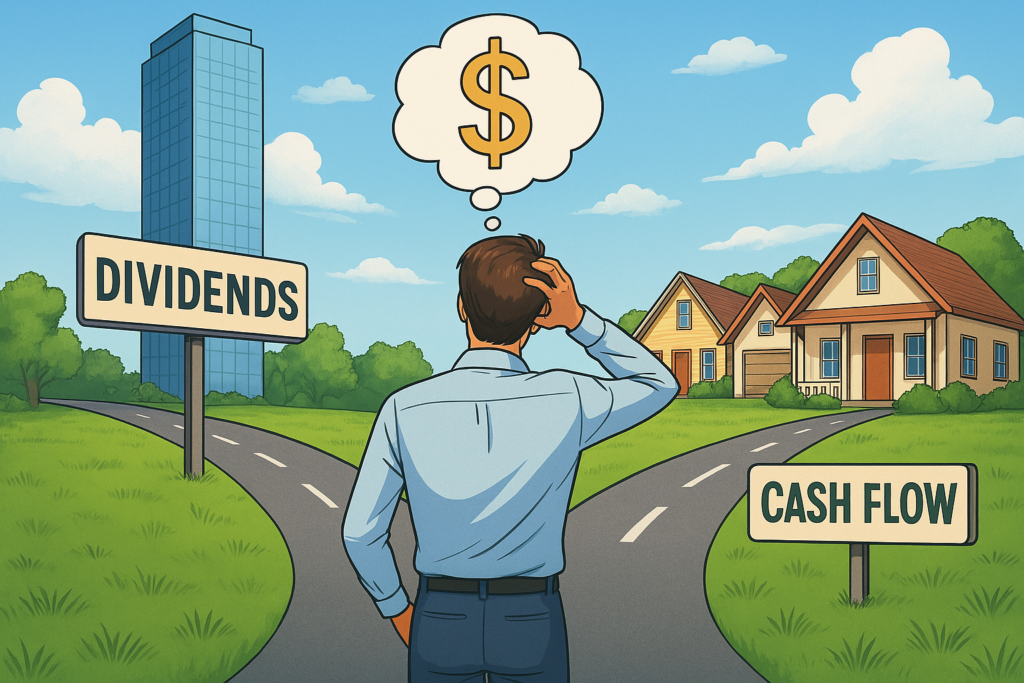Dividend Stocks vs Real Estate Cash Flow
You’ve got a little money set aside. You’re ready to make it work for you. But now you’re standing at the financial crossroads of a classic debate:
Should you invest in dividend stocks or real estate rentals?
Both promise passive income. Both are investor favorites. And both come with their own flavor of excitement—and headaches.
Let’s unpack what each really offers, compare the pros and cons, and help you decide which path fits your goals, lifestyle, and stomach for risk.

What Is Dividend Investing?
Dividend investing is about buying shares in companies that pay out a portion of their profits to shareholders—typically quarterly. These are often mature, stable businesses (think Coca-Cola, Johnson & Johnson, or utility companies) that reward loyalty with regular payouts.
Instead of hoping a stock skyrockets in value, you’re focusing on the steady drip of cash flow over time. It’s the stock market’s version of “mailbox money.”
And the best part? You don’t have to fix a leaky toilet to earn it. Be sure to check out our Dividend Investing page to learn more with an in-depth break down.
What Is Real Estate Cash Flow?
Real estate investing (in this context) usually means owning rental property and collecting rent that exceeds your expenses—known as positive cash flow.
Let’s say you buy a small home and rent it out. After the mortgage, insurance, taxes, and maintenance, you’re left with a few hundred bucks each month in profit. That’s your cash flow.
It’s like a business that prints money—if the printer doesn’t jam. Be sure to check out our How to Buy Your First Rental page if you are interested in learning more. If you’ve made it this far, you probably are at least a little curious. You can also go to the menu at the top and check out our entire Real Estate section for more knowledge and alternatives.
Check This Quick Comparison Table Out
| Dividend Stocks | Rental Real Estate | |
|---|---|---|
| Initial Effort | Low—open brokerage account, buy shares | High—property search, financing, rehab |
| Maintenance | Minimal—monitor portfolio | Ongoing—tenants, repairs, vacancies |
| Liquidity | High—sell anytime | Low—takes time to sell |
| Risk | Market risk, but diversified | Local market + property-specific risks |
| Cash Flow Timing | Quarterly (or monthly) | Monthly rent payments |
| Scalability | Easily scalable | More capital/time required to scale |
Which One Pays Better?
Let’s not sugarcoat it—real estate often produces more cash flow early on, especially if you leverage financing and manage properties yourself.
But dividend stocks come with less overhead, lower entry barriers, and zero tenant drama.
Here’s a basic breakdown:
- Dividend Portfolio: $100,000 earning 4% = $4,000/year
- Rental Property: $100,000 down on a $300,000 property could bring $6,000–$12,000/year in net income (after expenses)—but with more work
One isn’t clearly “better” than the other. It depends on how hands-on you want to be, how comfortable you are with debt, and how passive you want your income to be.
Taxes and Hidden Costs
With dividend stocks, qualified dividends often get favorable tax treatment—15% for most investors. Plus, there are no property taxes, maintenance, or insurance to worry about.
With real estate, the upside is depreciation—you can deduct part of your property’s value each year to lower your tax bill. But you’ll also face property taxes, repairs, and potential capital gains if you sell.
Pro tip: Real estate gets you more deductions, but stocks are simpler at tax time.
Stackonomics Takeaway
- Want something truly passive? Start with dividend stocks.
- Want higher potential cash flow and don’t mind the hustle? Rental properties can pay off.
- Want the best of both worlds? Diversify. Many investors use dividend income to help fund their next down payment—and real estate income to reinvest in the stock market.
You don’t have to choose one or the other. But understanding how each works is the first step to building a portfolio that prints money while you sleep.
